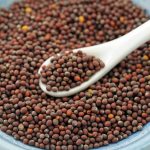 An annual vegetable related to the turnip. The seeds are used whole, ground or powdered and used as a condiment.
An annual vegetable related to the turnip. The seeds are used whole, ground or powdered and used as a condiment.
Although the mustard you put on a hamburger is made from the mustard plant, it was the condiment, not the plant, that was originally named mustard. The condiment acquired its name because it was made by grinding seeds—seeds harvested from what was once known as the senvy plant—into a paste that was then mixed with must, must being an old name for new wine. This must-based paste came to be known in French as moustarde, which English adopted as mustard when the British became fond of the condiment in the late thirteenth century. By the mid fourteenth century, the senvy plant had become so associated with the condiment made from its seeds that the plant itself came to be newly-known as mustard, and by the seventeenth century almost everyone had forgotten that the mustard plant had ever been called senvy. Incidentally, the must that gave rise to the word mustard derives from a Latin phrase, mustum vinum, meaning fresh wine. In English, this phrase was adopted in the ninth century as must, also meaning fresh wine, which in the fifteenth century briefly gave rise to the adjective musty, meaning fresh. This musty is now obsolete, having vanished in the sixteenth century thanks to the appearance of another musty, one meaning stale or mouldy. This second musty, which derives from the same source as the word moist, was so opposed in meaning to the first musty that it drove the older term out of existence.
Any member of the aromatic mustard family with yellow flowers and long, slender pod fruit.
Yellow powder of mustard seed used as a counterirritant, rubefacient, emetic, stimulant, and condiment.
The pulverized seeds of the herbaceous plant, bearing the same denomination, obtainable in either dehydrated or paste (processed) constitution.
Within the realm of mustard seeds, we encounter two prominent species that can be finely ground to produce distinct varieties: the vibrant yellow or white seeds and the dark-hued brown or black seeds. The black mustard seeds possess a captivating component known as myronic oil, which imparts a truly piquant flavor; however, this same oil renders them less suitable for extended storage, thereby affecting their keeping quality. In contrast, the white mustard seeds, although somewhat lacking in flavor intensity, exhibit superior longevity in terms of preservation. When it comes to commercially manufactured mustard powder, it typically consists of a harmonious blend of both mustard seed varieties, often accompanied by the addition of cereal wheat flour or alternative substances that effectively absorb the oil and hinder fermentation processes. Notably, powdered black mustard is a rarity in the market, seldom found available for purchase.
